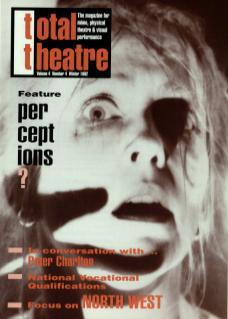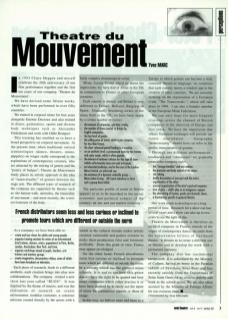In 1993 Claire Heggen and myself celebrate the 20th anniversary of our first performance together and the first ten years of our company, Théâtre du Mouvement.
We have devised some fifteen works, which have been performed in over fifty countries.
We trained in corporeal mime for four years alongside Étienne Decroux and also trained in dance, gymnastics, sports and diverse body techniques such as Alexander Feldenkrais and work with Odile Ronquet.
This training has enabled us to have a broad perspective on corporeal movement. At the present time, when traditional vertical terminologies (dance, theatre, mime, puppetry) no longer really correspond to the aspirations of contemporary creators, who are attracted by the mixing of genres and the ‘poetry of budges’, Théâtre du Mouvement freely places its artistic approach in the idea of ‘transversality’ of gesture between the stage arts. The different types of research of the company are supported by themes such as: the human walk, animality, the musicality of movement – and most recently, the scenic environment of the body.
As a company, we have been able to:
- Create and tour shows for adults and young people.
- Organise training sessions for actors of an international level (mimes, dancers, actors, puppeteers) in Paris, Berlin, London, Amsterdam, New York, and Lima.
- Organise workshops aimed at pupils, teachers, arts trainers and amateur groups.
- Create imaginative, documentary videos, some of which have been broadcast on television.
Each piece of research, leads to a different aesthetic, each creation brings into play new collaborations. The company created a new show last year called BUGS. It was inspired by the theme of insects, and was the realisation of research on scenic environment, modular costumes, and a sonorous universe created directly by the actors with a fairly complex dramaturgical script.
Mime Action Group asked us about the impressions we have had of mime in the UK in comparison to France or other European countries.
Each country is distinct and Britain is very different to France, Holland, Belgium or Spain. Gradually becoming aware of the mime field in the UK, we have been struck by a certain number of factors:
- The amount of companies, and their vitality.
- The number of shows toured in Britain by English companies.
- The low level of grants.
- The selling price of shows, which is per company, far less than France.
- The short rehearsal period leading to a creation.
- On an aesthetic level, a pronounced taste for the human and comic mode, which is often popular.
- The interest of national criticism for this type of show (which unfortunately does not exist in France).
- An interested audience, and in the case of the London Mime Festival, an informed one.
- The existence of a dynamic umbrella group – Mime Action Group. All French initiatives to form such a group have failed.
The particular profile of mime in Britain appears to us to be inscribed in the social, economic and political context of the country: an out and out market economy, which in the cultural domain makes artistic creation vulnerable and pushes creators to make their production first and foremost profitable. From this point of view, France may appear privileged.
On the other hand, French distributors seem less curious or inclined to promote tours which are different or outside the norm. In a country which has the greatest mime schools, it is sad to see how this genre doesn't have the right to be quoted and how many companies which either practice it or have been inspired by it, rarely use the name of mime for commercial reasons or those of image.
In this way, we believe more and more in a Europe in which gesture can become a truly common theatrical language, on condition that each country leaves a window ajar to the creation of other countries. We are currently working on the organisation of a European event, The Transversals, which will take place in 1994. I am also a founder member of the European Mime Federation.
We can only hope for more frequent crossings across the channel of British companies in the direction of Europe and vice versa. We have the impression that artistic European exchanges will provide our future nourishment. Geographic ‘transversality’ should have an echo in the artistic transversality of gesture.
Through our different performances, tendencies and ‘obsessions’ we gradually created the company style:
- The ‘strange familiar’ and non realism.
- The precision and body control of the actors.
- Risk-taking.
- Bodily dissociation of one part and the actor's organisation of the other.
- Musical organisation of the actor's gestural sequence.
- Love of play.
- Child's play as an imaginary support.
- The alternating of human, poetic and dramatic shows.
- A dramaturgy specific to gestural theatre.
Our work tends to develop over a long period of time. Research for a show can last several years and a show can take up to two years to see the light of day.
Théâtre du Mouvement is therefore an atypical company in France, outside of the vogue of contemporary dance, set aside from the conservative fortress of text-based theatre. It pleases us to create a different sort of theatre and to develop the work with a permanent company.
The company also has institutional recognition: it is subsidised by the Ministry of Culture, having its home in the Parisian suburb of Pavillons Sous Bois and has recently received subsidy from the Department of Seine Saint Denis for its creative activity and work in the school sector. We are also often assisted by the Ministry of Foreign Affairs for our overseas tours.
Translated by Sue Mitchell.

